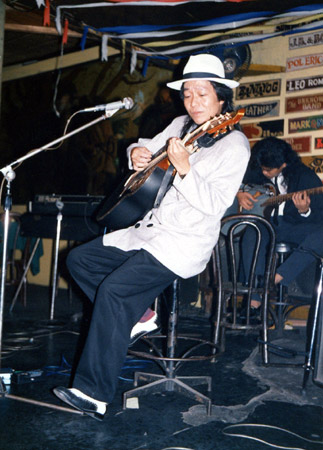Music: Modern Forms
Pinoy Jazz
(Pinoy is a slang term for “Filipino.” Originally somewhat pejorative, it has become standard usage.)
Filipino musicians were involved with jazz from its earliest days, through contact with African American servicemen as far back as 1898, and through a steady stream of returning immigrants. Some scholars think there were Filipino musicians in New Orleans during the early part of the 20th century who were present at the birth of jazz.
A jazz scene developed in Manila by the 1920s; big bands in the swing era played in Manila hotels and toured the USA. Jazz continues to be part of Manila, and musicians are looking to Filipino traditional music for inspiration, forming a jazz fusion that looks back to old folk melodies and forward to rock music.
The Manila Sound
The Manila Sound, soft rock with Tagalog lyrics, appeared in the early 1970s. For a short time immensely popular, it devolved into disco and self-parody. By the end of the 1970s it had been superceded by Original Philippine Music.
Pinoy Rock and Original Pinoy Music (OPM)
The softer, more commercial Manila Sound was overshadowed by the rise of Pinoy rock: bouncy, American-influenced, guitar-oriented rock, often sung in Tagalog and using Filipino folk song material. (Other language groups produced their own rock and roll. In Visayas, for example, Bisrock, in Visayan languages, became popular.)
Pinoy rock had a strong nationalist strain, and many songs expressed Filipino patriotism and sense of national identity. The Juan Dela Cruz Band was a pioneer of patriotic rock, and their song “Ang Himig Natin” (“Our Music”) was important to a growing sense of Filipino national pride.
Pinoy rock gathered steam all through the 1970s. In 1986 the new government of Corazon Aquino passed a law requiring a certain percentage of radio play to be original Filipino music, written, performed, and produced in the Philippines.
Punk, reggae, ska, and hip-hop have since provided competition for Pinoy rock, but popular bands like the Eraserheads kept the sound alive into the 1990s.
Folk Rock, Neo-traditional
In spite of the overwhelming influences coming from abroad, Filipino folk music always remained popular. The patriotic bent of Pinoy rock naturally led to folk rock, and one of the most popular exponents was Freddie Aguilar. His first big hit, sung in Tagalog, was “Anak,” in 1978. During the years of the Marcos dictatorship, he wrote songs protesting the government. And his patriotic song “Bayan Ko” (“My Country”) became one of the anthems of the People Power Revolution of 1986.
Pinoy Punk
Filipinos discovered punk rock early on. The music and especially the oppositional lifestyle resonated with disaffected and alienated young Filipinos. Bands like Betrayed, Wuds, and the Dead Ends sang punk, thrash, and hardcore in Tagalog. At some point, punk and new wave music separated out, with new wave dubbed chong music, with jangly guitars, reggae rhythms, and a gentler sound.
Pinoy Reggae and Ska
Like Hawaii and its Jawaiian version of reggae, the tropical islands of the Philippines were very hospitable to Jamaican music, and both reggae and ska have many local exponents. The Visayas region is especially rich in reggae.
An interesting synthesis of Filipino-language folkloric and pop music continuity is the band Tropical Depression, headed by record producer “Pappadom” Gamboa. Tropical Depression sometimes uses Filipino traditional instruments in performance, and the band has recorded a reggae rendition of the Pinoy rock anthem “Ang Himig Natin” by the Juan Dela Cruz Band.
Pinoy Hip-Hop
Hip-hop appeared in Filipino clubs in the early 1980s, though it took a while to develop an audience. While some Filipino rap reproduces the violent, misogynist ethos of American gangsta rap, there is a strong strain of Pinoy patriotism, with rap in Tagalog and other Philippine languages. Francis Magalona, known as Francis M, was a pioneer of Filipino hip-hop, releasing the first Filipino rap record in 1990, and recording patriotic and politically conscious rap like “Mga Kakabayan Ko” (My Countrymen) and “Tayo’y Mga Pinoy” (We Are Filipinos). Filipino hip-hop is continuing a tradition of using outside musical influence as a vehicle for political songwriting that goes back at least to the patriotic kundiman of the 19th century.
Article written for World Trade Press by Marc Lecard.
Copyright © 1993—2025 World Trade Press. All rights reserved.

 Philippines
Philippines 